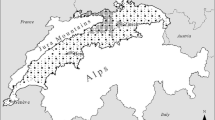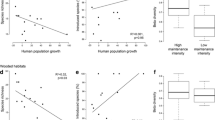Abstract
The rapid urbanization of the world has significant ecological consequences that shape global biodiversity patterns. The plant communities now common in urban centers may represent new habitats with unique dynamics and the potential for highly modified ecological services. This study, joining extensive spatial and floristic data sets, examined current distribution patterns of non-native and native woody plant species in the New York metropolitan region, USA. We joined the New York Metropolitan Flora (NYMF) database of woody species with GIS data of urban land cover for 297 5 km by 5 km landscape blocks. We tested the relationship between urbanization and native and non-native species richness patterns, the extent of non-native species presence in the urban area, and the change in beta diversity across a gradient of urban land cover. We found that across the urban–rural gradient, native plant species richness decreased and non-native species richness increased with increasing urban land cover. Total richness does not change across the urban–rural gradient. Our analyses show that these patterns are highly correlated with urbanization, but vary across the New Jersey landscape. We also found an increase in beta diversity with urbanization; urban areas are not homogenized in plant species composition compared to rural areas. Here we show a species-rich flora dominated by non-native species which are differentiating the urban flora. These results can help guide appropriate conservation decisions for the maintenance of plant biodiversity in cities.



Similar content being viewed by others
References
Aronson MFJ, La Sorte FA, Nilon CH, Katti M, Goddard MA, Lepczyk CA, Warren PS, Williams NSG, Cilliers S, Clarkson B, Dobbs C, Dolan R, Hedblom M, Klotz S, Louwe Kooijmans J, Kühn I, MacGregor-Fors I, McDonnell M, Mörtberg U, Pyšek P, Siebert S, Sushinsky J, Werner P, Winter M (2014) A global analysis of the impacts of urbanization on bird and plant diversity reveals key anthropogenic drivers. Proc R Soc B 281:20133330
Bridgewater PB (1990) The role of synthetic vegetation in present and future landscapes of Australia. Proc Ecol Soc Aust 16:129–134
Burton ML, Samuelson LJ, Pan S (2005) Riparian woody plant diversity and forest structure along an urban–rural gradient. Urban Ecosyst 8:93–106
Chocholoušková Z, Pyšek P (2003) Changes in composition and structure of urban flora over 120 years: a case study of the city of Plzeň. Flora 198:366–376
Clemants SE, Moore G (2003) Patterns of species diversity in eight Northeastern United States cities. Urban Habitats 1:4–16, Available at http://www.urbanhabitats.org/v01n01/speciesdiversity_full.html
Deutschewitz K, Lausch A, Kühn I, Klotz S (2003) Native and alien plant species richness in relation to spatial heterogeneity on a regional scale in Germany. Glob Ecol Biogeogr 12:299–311
Fortin M-J, James PMA, MacKenzie A, Melles SJ, Rayfield B (2012) Spatial statistics, spatial regression, and graph theory in ecology. Spat Stat 1:100–109
Gilbert OL (1989) The ecology of urban habitats. Chapman and Hall, New York
Grimm NB, Faeth SH, Golubiewski NE, Redman CR, Wu J, Bai X, Briggs JM (2008) Global change and the ecology of cities. Science 319:756–760
Hahs AK, McDonnell MJ, McCarthy MA, Vesk PA, Corlett RT, Norton BA, Clemants SE, Duncan RP, Thompson K, Schwartz MW, Williams NSG (2009) A global synthesis of plant extinction rates in urban areas. Ecol Lett 12:1165–1173
Handel SN (2013) Ecological restoration foundations to designing habitats in urban areas. In: Beardsley J (ed) Designing wildlife habitats. Garden and Landscape Studies, Dumbarton Oaks Research Library, Washington, D.C., pp 169–186
Hanski I, Gaggiotti OE (2004) Ecology, genetics, and evolution of metapopulations. Elsevier, Amsterdam
Hobbs F, Stoops N (2002) Demographic trends in the 20th Century. U.S. Census Bureau, Census 2000 Special Reports, Series CENSR-4, U.S. Government Printing Office, Washington, D.C.
Hobbs RJ, Arico S, Aronson J, Baron JS, Bridgewater P, Cramer VA, Epstein PR, Ewel JJ, Klink CA, Lugo AE, Norton D, Ojima D, Richardson DM, Sandersonj EW, Valladares F, Vilà M, Samora R, Sobel M (2006) Novel ecosystems: theoretical and management aspects of the new ecological world order. Glob Ecol Biogeogr 15:1–7
Knapp S, Kühn I, Stolle J, Klotz S (2010) Changes in the functional composition of a Central European urban flora over three centuries. Perspect Plant Ecol 12:235–244
Kowarik I (1995) On the role of alien species in urban flora and vegetation. In: Pyšek J, Prach K, Rejmánek M, Wade M (eds) Plant invasions: general aspects and special problems. SPB Academic Publishing, Amsterdam, pp 85–103
Kowarik I, von der Lippe M, Cierjacks A (2013) Prevalence of alien versus native species of woody plants in Berlin differs between habitats and at different scales. Preslia 85:113–132
Kühn I, Klotz S (2006) Urbanization and homogenization – comparing the floras of urban and rural areas in Germany. Biol Conserv 127:292–300
Kühn I, Brandl R, Klotz S (2004) The flora of German cities is naturally species rich. Evol Ecol Res 6:749–764
La Sorte FA, McKinney ML, Pyšek P (2007) Compositional similarity among urban floras within and across continents: biogeographical consequences of human-mediated biotic interchange. Glob Chang Biol 13:913–921
La Sorte FA, McKinney ML, Pyšek P, Klotz S, Rapson GL, Celesti-Grapow L, Thompson K (2008) Distance decay of similarity among European urban floras: the impact of anthropogenic activities on β diversity. Glob Ecol Biogeogr 17:363–371
Lathrop R (2004) Measuring land use change in New Jersey: land use update to year 2000. CRSSA Publication #17-2004-1. Center for Remote Sensing & Spatial Analysis, Rutgers University, New Brunswick
Lichstein JW, Simons TR, Shriner SA, Franzreb KE (2002) Spatial autocorrelation and autoregressive models in ecology. Ecol Monogr 72:445–463
Lockwood JL, McKinney ML (2001) Biotic homogenization: the loss of diversity through invasion and extinction. Kluwer Academic/Plenum Publishers, New York
Martine G (2007) State of the world population: unleashing the potential of urban growth. United Nations Population Fund. Available at http://www.unfpa.org/swp/swpmain.htm
McCune B, Grace JB (2002) Analysis of ecological communities. MjM Software, Gleneden Beach, Oregon
McCune B, Medford MJ (1999) PC-ORD for windows: multivariate analysis of ecological data, Version 4.10. MjM Software Design, Gleneden Beach, Oregon
McDonnell MJ, Hahs AK (2008) The use of gradient analysis studies in advancing our understanding of the ecology of urbanizing landscapes: current status and future directions. Landsc Ecol 23:1143–1155
McDonnell MJ, Pickett STA, Groffman P, Bohlen P, Pouyat RV, Zipperer WC, Parmelee RW, Carreiro MM, Medley K (1997) Ecosystem processes along an urban–rural gradient. Urban Ecosyst 1:21–36
McKinney ML (2002a) Do human activities raise species richness? Contrasting patterns in United States plants and fishes. Glob Ecol Biogeogr 11:343–348
McKinney ML (2002b) Urbanization, biodiversity, and conservation. Bioscience 52:883–890
McKinney ML (2004a) Measuring floristic homogenization by non-native plants in North America. Glob Ecol Biogeogr 13:47–53
McKinney ML (2004b) Citizens as propagules for exotic plants: measurement and management implications. Weed Technol 18:1480–1483
McKinney ML (2006) Urbanization as a major cause of biotic homogenization. Biol Conserv 127:247–260
McKinney ML (2008) Effects of urbanization on species richness: a review of plants and animals. Urban Ecosyst 11:161–176
McKinney ML, Lockwood JL (1999) Biotic homogenization: a few winners replacing many losers in the next mass extinction. Trends Ecol Evol 14:450–453
Melles SJ (2005) Urban bird diversity as an indicator of human social diversity and economic inequality in Vancouver, British Columbia. Urban Habitats 3:25–48
Miller JR (2005) Biodiversity conservation and the extinction of experience. Trends Ecol Evol 20:430–434
Moore G, Steward A, Clemants S, Glenn S, Ma J (2003) An overview of the New York Metropolitan Flora project. Urban Habitats 1:17–24, Available at: http://www.urbanhabitats.org/v01n01/nymf_full.html
Myers JH, Bazely DR (2003) Ecology and control of introduced plants. Cambridge Univ. Press, Cambridge
Olden JP, Poff NL, McKinney ML (2006) Forecasting faunal and floral homogenization associated with human population geography in North America. Biol Conserv 127:261–271
Pouyat RV, McDonnell MJ, Pickett STA (1997) Litter decomposition and nitrogen mineralization in oak stands along an urban–rural land use gradient. Urban Ecosyst 1:117–131
Pouyat RV, Russell-Anelli J, Yesilonis ID, Groffman PM (2002) Soil carbon in urban forest ecosystems. In: Kimble KM, Heath LS, Birdsey RA, Lal R (eds) The potential of U.S. forest soils to sequester carbon and mitigate the greenhouse effect. CRC Press, Boca Raton, pp 347–362
Pyšek P (1998) Alien and native species in Central European urban floras: a quantitative comparison. J Biogeogr 25:155–163
Pyšek P, Bacher S, Chytrý M, Jarošík V, Wild J, Celesti-Grapow J, Gassó N, Kenis M, Lambdon PW, Nentwig W, Pergl J, Roques A, Sádlo J, Solarz J, Vilà M, Hulme PE (2010) Contrasting patterns in the invasions of European terrestrial and freshwater habitats by alien plants, insects and vertebrates. Glob Ecol Biogeogr 19:317–331
Qian H, Guo Q (2010) Linking biotic homogenization to habitat type, invasiveness and growth form of naturalized alien plants in North America. Divers Distrib 16:119–125
Rangel TF, Diniz-Filho AF, Bini LM (2010) SAM: a comprehensive application for spatial analysis in macroecology. Ecography 33:46–50
Reichard SH, Hamilton CW (1997) Predicting invasions of woody plants introduced into North America. Conserv Biol 11:193–203
Ricotta C, Godefroid S, Rocchini D (2010) Patterns of native and exotic species richness in the urban flora of Brussels: rejecting the ‘rich get richer’ model. Biol Invasions 12:233–240
Robinson GR, Yurlina ME, Handel SN (1994) A century of change in the Staten Island flora: patterns of species loss and additions. B Torrey Bot Clb 121:119–129
Rooney TP, Wiegmann SM, Rogers DA, Waller DM (2004) Biotic impoverishment and homogenization in unfragmented forest understory communities. Conserv Biol 18:787–798
Roy DB, Hill MO, Rothery P (1999) Effects of urban land cover on the local species pool in Britain. Ecography 22:507–515
Seto KC, Güneralp B, Hutyra LR (2012) Global forecasts of urban expansion to 2030 and direct impacts on biodiversity and carbon pools. PNAS 109:16083–16088
Sukopp H, Wurzel A (2003) The effects of climate change on the vegetation of central European cities. Urban Habitats 1:66–86
Turner WR, Nakamura T, Dinetti M (2004) Global urbanization and the separation of humans from nature. Bioscience 54:585–590
United Nations Environment Programme, Urban Environment Unit (2007) Report of the cities and biodiversity: achieving the 2010 diversity target. UNEP/CBD/Cities/1/3. Available at: http://www.cbd.int/doc/meetings/biodiv/mayors-01/official/mayors-01-03-en.doc
USDA, NRCS (2010) The PLANTS database. National Plant Data Center, Baton Rouge. Available at: http://plants.usda.gov
Vitousek PM, Mooney HA, Lubchenco J, Melillo JM (1997) Human domination of the earth’s ecosystems. Science 277:494–499
Wania A, Kühn I, Klotz S (2006) Plant richness patterns in agricultural and urban landscapes in Central Germany—spatial gradients of species richness. Landsc Urban Plan 75:97–110
Wilcove DS, Rothstein D, Dubow J, Phillips A, Losos E (1998) Quantifying threats to imperiled species in the United States. Bioscience 48:607–615
Williams NSG, Schwartz MW, Vesk PA, McCarthy MA, Hahs AK, Clemants SE, Corlett RT, Duncan RP, Norton BA, Thompson K, McDonnell MJ (2009) A conceptual framework for predicting the effects of urban environments on floras. J Ecol 97:4–9
Williamson MH (1996) Biological invasions. Chapman and Hall, London
Winter M, Schweiger O, Klotz S, Nentwig W, Andriopoulos P, Arianoutsou M, Basnou C, Delipetrou P, Didžiulis V, Hejda M, Hulme PM, Lambdon PW, Pergl J, Pyšek P, Roy DB, Kühn I (2009) Plant extinctions and introductions lead to phylogenetic and taxonomic homogenization of the European flora. PNAS 106:21721–21725
Wittig R (2004) The origin and development of the urban flora of Central Europe. Urban Ecosyst 7:323–339
Acknowledgments
We thank the Brooklyn Botanic Garden for the use of the New York Metropolitan Flora data set and the Grant F. Walton Center for Remote Sensing and Spatial Analysis at Rutgers University for use of land use data sets. We thank P. Smouse, P.J. Morin, J. Gurevitch, and two anonymous reviewers for manuscript comments. We also thank Thomas Young for graphical expertise. This paper is dedicated to our colleague and friend, Steven Clemants, whose warmth, dedication, and significant contribution to the science and conservation of urban floras is greatly missed.
Author information
Authors and Affiliations
Corresponding author
Additional information
S.E. Clemants is deceased.
Rights and permissions
About this article
Cite this article
Aronson, M.F.J., Handel, S.N., La Puma, I.P. et al. Urbanization promotes non-native woody species and diverse plant assemblages in the New York metropolitan region. Urban Ecosyst 18, 31–45 (2015). https://doi.org/10.1007/s11252-014-0382-z
Published:
Issue Date:
DOI: https://doi.org/10.1007/s11252-014-0382-z




